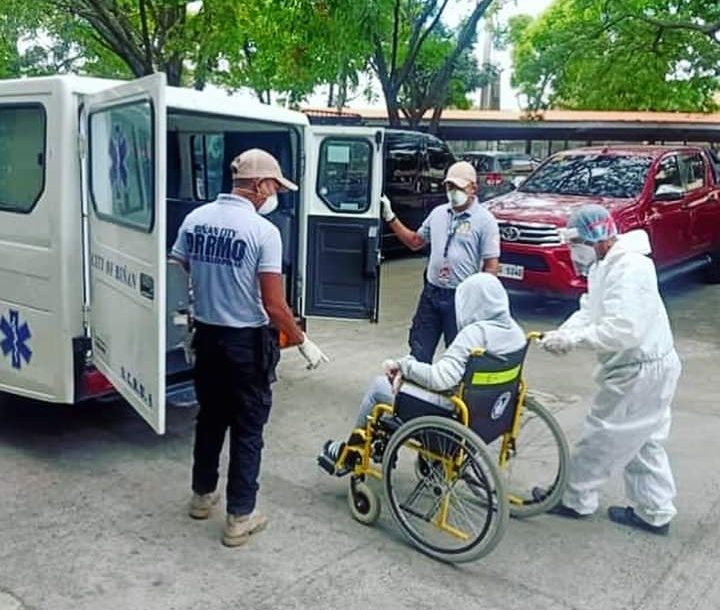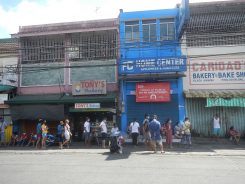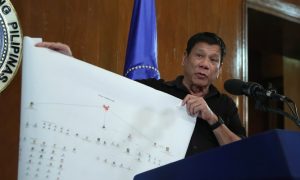What does it take to really listen to science and not just don its visage, to use the funds lost somewhere in the oblivion of this fiscal black hole, and to invest on the health and well-being of ordinary Filipinos using carefully analysed data?
It has been a story of vicious cycles, of the same mistakes being made, and the same solution being forced on to a recurring health problem that demands something radically different.
In grade school arithmetic, you cannot arrive at a wrong solution and force everyone to believe that 2+2=5 is correct. Yet, this is exactly how the Philippine government behaves. They believe that with enough people, they can mob the math and shape reality, that if enough people forget about COVID-19, we can go about business as usual.
The president downplayed the virus. An infectious disease expert and adviser to the Inter-Agency Task Force for the Management of Emerging Infectious Diseases (IATF) once declared “we contained this.” The health secretary did not recommend an early travel ban because it might cause hurt feelings.
When the pandemic finally struck, the cycle of confusion commenced. Spotlighting individual solutions for a public health problem started. The poor and powerless were blamed, i.e. the “pasaway.”
The ostensible use of “science” as a basis for bad policies diverts attention away from the whole-of-society approach needed to solve the pandemic: mass testing, adequate contact tracing, increase in vaccine supply and its humane rollout. Will it hurt to try those out instead of dismissing it, like how they keep putting words in critics’ mouths that “mass” means “all?”
Look at Cebu’s governor, how she refuses to wear a mask and blames everyone except herself for the surge of cases in the province. She falsely claimed that Tu-ob, a Cebuano term for salt water steam inhalation that puts users at risk for serious burns, is a cure for COVID-19, and made its use an official policy of the province. She shamed a general practitioner for being “just a general practitioner” in one of her FB livestreams. After the death of her brother, she sued the very heroes of this pandemic.
Then there’s another surge, and the same humourless comedy plays. Only, real people die, and more each day. Deaths gradually hit closer to our homes.
Truth is a harsh reality to navigate. COVID-19 will not go away with just mere rhetoric, face-value science, and false narratives. The refusal to face reality puts all of us in danger. Yet this danger is more pronounced in the powerless, the ones whose realities are starkly different from those sitting safely behind desks. The problem stems from the “normal” that corruption and capitalism has created. When there is failure to invest in public transport, there is failure to uphold the rights of ordinary citizens. Skyways are made for toll payers with cars, while those living underneath it are made to languish, breathing in each other’s breath trying to make a living, a serious risk to life in the time of COVID-19.
Yet, as lockdowns loosened, the lines to public transport once again became crowded. Workers go back to enduring long lines to ride transports now further marred by rules on physical distancing. Then the heavy traffic and crowded trains returned, the very risk factors that allowed SARS-CoV-2 to thrive. Nothing really changed.
The solution? Another lockdown. The powerful lament the losses in their businesses, the middle class tighten their belts, and the poor struggle to stay alive. A lockdown might kill daily wage earners, but an open economy will do the same. The difference lies in COVID-19’s indiscriminate killing of the rich and the poor. Lockdowns, less so.
The vaccines were supposed to be the endgame, our exit strategy, until the Delta variant changed this. Vaccines were touted as the cavalry we have been waiting for. But epidemiological data points to a grim truth: that herd immunity, a goal post that was once pegged at 70% of vaccinated individuals in a population, might no longer be possible. With 6-9 people getting infected by 1 person with Delta, SARS-CoV-2 no longer relies on superspreader events to initiate massive outbreaks. Its Re, or effective reproduction number, remains high despite vaccination. With vaccination, the disease might go away, but the virus will not.
In the Philippines, every lockdown feels like taking not two steps back, but hundreds. There are two tiers to the system, a private sector that adopts a hospital-centric, private insurance-based model of healthcare delivery, and a public sector crippled by inefficiencies and red tape that results in low-quality care delivery for most Filipinos. The market of healthcare has never actually worked, with more than 50% of Filipinos utilizing out-of-pocket expenditure for healthcare services, setting families back with enormous healthcare debts, and individuals resorting to crowdfunding to pay for the bills.
The reasons for this failure stood out starkly with billions of public funds sketchily spent or lost, healthcare workers still deprived of benefits, and ordinary citizens denied of the purchasing power to avail healthcare. The fiction that private healthcare is inherently better and more efficient is enforced by the persisting woes of undermanned, overburdened, and infrastructurally challenged local health units outside of the big three cities of Manila, Cebu, and Davao.
These local health units are tasked with the most important aspect of health care: primary and secondary prevention of disease, a concept alien to the current financial set-up that incentivises the more curative aspects of health. The community is where defeating epidemics—whether infectious or non-infectious diseases—should begin and end.
Health is not just about the individual. It is never just someone who had a heart attack or stroke, it is a society exposed to a barrage of ads on fast food and cigarettes, to a lack of place for safe exercise amid polluted, hazardous roads, and to a want of accessible medications for chronic illnesses.
It is never just about a person languishing in the COVID-19 ICU. It is a society subjected to crowded jeepneys and buses as they spend hours stuck in endless traffic, literally breathing on each other’s necks; to bad workplace set ups with long hours, poor ventilation, and meager pay; to insurance companies that do not cover pre-existing conditions; to poor contact tracing for confirmed and suspected cases; to a lack of accessible and affordable RT PCR Swab tests; and to an egregiously slow and uneven vaccine roll-out.
Rodrigo Duterte’s war on COVID-19 is a war on the Filipino people
Reports emerging of anti-communist attacks in cities and rural areas, arrests of activists and union members, and military action in spite of a declared ceasefire.
These realities seemed to be divorced from the eyes of the Inter-Agency Task Force. “We can always lockdown again,” says one official, like it is the only solution that can be offered to this disease. “Arrest the unvaccinated,” says the president, like it is the only answer to the COVID-19 question, like the exit strategy with Delta in tow hinges solely on the jab.
A society’s health is beholden to policies and those who make it. It is also beholden to the perception of the very society that got used to the same inefficiencies that it has become a cultural quirk. “If God will take me then so be it,” says an elderly lady in her stark refusal to get the COVID-19 vaccine. “I’m too fearful, doc,” says another, manifesting the anxiety that medicine summons in their consciousness: images of dramatic bleeds, of beeping dialysis machines, of non-healing wounds, and sudden deaths of a “friend of a friend” come into their minds. There is a fundamental lack of faith in the process, and it is our task as physicians to correct it.
Enter pseudo-science based quick fixes touted by politicians such as ivermectin, cleaning masks with gasoline, and air purifier necklaces. Our once simple task became harder a hundredfold.
If we’re going to get out of this, the solution should go deep in the heart of the health care system. We need a transformation that cracks open the nigh-impenetrable wall that deprives health care access to all Filipinos and renew their faith on the system.
We need a whole-of-society approach that focuses on communities instead of individuals by allotting greater investment on primary health care while also improving secondary care access in each region to truly minimize critical illnesses and deaths due to preventable diseases. Clear and efficient referral systems to tertiary networks should also be established per region for cases that require specialist care. To truly live up to the call of Universal Healthcare, the obvious must be done: better funding of health infrastructure, empowerment of healthcare workers, and purging corruption in the health sector whether public or private.
If no transformation occurs, I am afraid COVID-19 will be another Tuberculosis: a disease of the weak, the poor, the marginalised, so utterly normalised, and chronically unresolved; a reality shaped by those in power, denied by the unaffected, and feared by the vulnerable. Our very own 2+2=5.
So, the cycle continues: the Philippines is in another surge, another lockdown, more bickering, until its people get tired, and COVID-19 inevitably becomes endemic. Infections become the accountability of the individual instead of society, whose very cancer is manifested by an inane government.
An immunocompromised society. The sick man of Asia.
 Facebook
Facebook  Twitter
Twitter  Soundcloud
Soundcloud  Youtube
Youtube  Rss
Rss 



